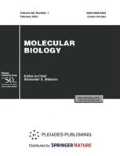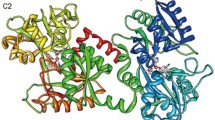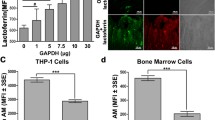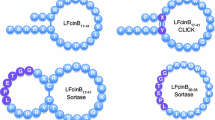Abstract
Lactoferrin (LF) is a Fe3+-transferring glycoprotein and is contained in human barrier fluids, blood, and milk. LF is an acute phase protein, is involved in nonspecific defense, and displays a unique set of biological functions. Small-angle X-ray scattering and light scattering experiments demonstrated that DNA and oligosaccharides added to LF with various levels of initial oligomerization increased the oligomerization rate. Almost complete dissociation into monomers was observed when 1 M NaCl was added to LF oligomers obtained in the presence of DNA, oligosaccharides, and nucleotides, previously identified as oligomerization effectors. LF complexes obtained with different oligomerization effectors differed in stability. Incubation with 50 mM MgCl2 completely destructed LF complexes formed in the presence of ATP and oligosaccharides but only partly destructed AMP- and d(pT)10-dependent complexes, which was followed by the formation of new complexes with a higher salt stability. A possible role of oligomerization in various LF functions is discussed.
Similar content being viewed by others
References
Anderson B., Baker H., Norris G., Rice D., Baker E. 1989. Structure of human lactoferrin: Crystallographic structure analysis and refinement at 2.8 Å resolution. J. Mol. Biol. 209, 711–734.
van Berkel P., van Veen H., Geerts M., de Boer H., Nuijens J. 1996. Heterogeneity in utilization of N-glycosylation sites Asn624 and Asn138 in human lactoferrin: A study with glycosylation-site mutants. Biochem. J. 319, 117–122.
Sousa M., Brock J. 1989. Iron in immunity. Cancer and Inflammation. N.Y.: Wiley.
Birgens H. 1985. Lactoferrin in plasma measured by an ELISA technique: evidence that plasma lactoferrin is an indicator of neutrophil turnover and bone marrow activity in acute leukemia. Scand. J. Haematol. 34, 326–331.
Levay P., Viljoen M. 1995. Lactoferrin: A general review. Haematologica. 80, 252–267.
Kanyshkova T.G., Buneva V.N., Nevinsky G.A. 2001. Lactoferrin and its biological functions. Biokhimiya. 66, 5–13.
Chapple D.S., Mason D.J., Joannou C.L., Odell E.W., Gant V., Evans R.W. 1998. Infect. Immun. 66, 2434–2440.
van der Strate B.W., Beljaars L., Molema G., Harmsen M.C., Meijer D.K. 2001. Antiviral activities of lactoferrin. Antiviral. Res. 52, 225–239.
Kijlstra A. 1990. The role of lactoferrin in the nonspecific immune response on the ocular surface. Reg. Immunol. 3, 193–197.
Zhang W., Lachmann P.J. 1996. Neutrophil lactoferrin release induced by IgA immune complexes can be mediated either by Fc α receptors or by complement receptors through different pathways. J. Immunol. 156, 2599–2606.
Bagby G.C. Jr. 1989. Regulation of granulopoiesis: The lactoferrin controversy. Blood Cells. 15, 386–399.
Nishiya K., Horwitz D.A. 1982. Contrasting effects of lactoferrin on human lymphocyte and monocyte natural killer activity and antibody-dependent cell-mediated cytotoxicity. J. Immunol. 129, 2519–2523.
Rejman J.J., Turner J.D., Oliver S.P. 1994. Characterization of lactoferrin binding to the MAC-T bovine mammary epithelial cell line using a biotin-avidin technique. Int. J. Biochem. 26, 201–206.
Ziere G.J., Bijsterbosch M.K., van Berkel T.J.C. 1993. Removal of 14 N-terminal amino acids of lactoferrin enhances its affinity for parenchymal liver cells and potentiates the inhibition of β-very low density lipoprotein binding. J. Biol. Chem. 268, 27069–27075.
Tsuda H., Sekine K., Fujita K., Ligo M. 2002. Cancer prevention by bovine lactoferrin and underlying mechanisms: A review of experimental and clinical studies. Biochem. Cell Biol. 80, 131–136.
Yoo Y.C., Watanabe R., Koike Y., Mitobe M., Shimazaki K., Watanabe S., Azuma I. 1997. Apoptosis in human leukemic cells induced by lactoferricin, a bovine milk protein-derived peptide: Involvement of reactive oxygen species. Biochem. Biophys. Res. Commun. 237, 624–628.
van Berkel P.H., Geerts M.E., van Veen H.A., Mericskay M., de Boier H., Nuijens J.H. 1997. N-terminal stretch Arg2, Arg3, Arg4 and Arg5 of human lactoferrin is essential for binding to heparin, bacterial lipopolysaccharide, human lysozyme and DNA. Biochem. J. 328, 145–151.
Bennett R.M., Davis J. 1982. Lactoferrin interacts with deoxyribonucleic acid: A preferential reactivity with double-stranded DNA and dissociation of DNA-anti-DNA complexes. J. Lab. Clin. Med. 99, 127–138.
He J., Furmanski P. 1995. Sequence specificity and transcriptional activation in the binding of lactoferrin to DNA. Nature. 373(6516), 721–724.
Fleet J. 1995. A new role for lactoferrin: DNA binding and transcription activation. Nutr. Rev. 53, 226–227.
Furmanski P., Li Z., Fortuna M., Swamy C., Das M. 1989. Multiple molecular forms of human lactoferrin. Identification of a class of lactoferrins that possess ribonuclease activity and lack iron-binding capacity. J. Exp. Med. 170, 415–429.
Kanyshkova T., Babina S., Semenov D., Isaeva N., Vlassov A., Neustroev K., Kul’minskaya A., Buneva V., Nevinsky G. 2003. Multiple enzymic activities of human milk lactoferrin. Eur. J. Biochem. 270, 3353–3361.
Babina E.S., Semenov D.I., Buneva V.N., Nevinsky G.A. 2005. Human milk lactoferrin hydrolyzes ribonucleoside 5′-triphosphates. Mol. Biol. 39, 513–520.
Semenov D., Kanyshkova T., Buneva V., Nevinsky G. 1999. Human milk lactoferrin binds ATP and dissociates into monomers. Biochem. Mol. Biol. Int. 47, 177–184.
Babina S., Nevinsky G. 2004. Lactoferrin interacts with nucleotides. Nucleosides Nucleotides Nucleic Acids. 23, 1043–1046.
Mantel C., Miyazawa K., Broxmeyer H. 1994. Physical characteristics and polymerization during iron saturation of lactoferrin, a myelopoietic regulatory molecule with suppressor activity. Adv. Exp. Med. Biol. 357, 121–132.
Bagby G., Bennet R. 1982. Feedback regulation of granulopoiesis: Polymerization of lactoferrin abrogates its ability to inhibit CSA production. Blood. 60, 108–112.
Babina S.E., Tuzikov F.V., Tuzikova N.A., Buneva V.N., Nevinsky G.A. 2006. Effect of nucleotides on the oligomeric state of human lactoferrin. Mol. Biol. 40, 137–150.
Babina S.E., Kanyshkova T.G., Buneva V.N., Nevinsky G.A. 2004. Lactoferrin: A major deoxyribonuclease in human milk. Biokhimiya. 69, 1239–1250.
Svergun D.I., Feigin L.A. 1986. Rentgenovskoe i neitronnoe malouglovoe rasseyanie (Small Angle X-Ray and Neutron Scattering), Moscow: Nauka, pp. 50–279.
Fersht A. 1985. Enzyme Structure and Mechanism. N.Y.: Freeman.
Kanyshkova T., Semenov D., Buneva V., Nevinsky G. 1999. Human milk lactoferrin binds two DNA molecules with different affinities. FEBS Lett. 451, 235–237.
Anderson B.F., Baker H.M., Norris G.E., Rice D.W., Baker E.N. 1989. Structure of human lactoferrin: Crystallographic structure analysis and refinement at 2.8 Å resolution. J. Mol. Biol. 209, 711–734.
Nevinsky G., Babina S. 2003. Human milk lactoferrin and its polyfunctional biological functions. In: Protein Structures. Kaleidoscope of Structural Properties and Functions. Ed. Uversky V.N. India: Research Signpost, vol. 5, pp. 499–530.
Watanabe T., Nagura H., Watanabe K., Brown W. 1984. The binding of human milk lactoferrin to immunoglobulin A. FEBS Lett. 168, 203–207.
Author information
Authors and Affiliations
Corresponding author
Additional information
Original Russian Text © S.E. Soboleva (Babina), F.V. Tuzikov, N.A Tuzikova, V.N. Buneva, G.A. Nevinsky, 2009, published in Molekulyarnaya Biologiya, 2009, Vol. 43, No. 1, pp. 157–165.
Rights and permissions
About this article
Cite this article
Soboleva (Babina), S.E., Tuzikov, F.V., Tuzikova, N.A. et al. DNA and oligosaccharides stimulate oligomerization of human milk lactoferrin. Mol Biol 43, 142–149 (2009). https://doi.org/10.1134/S0026893309010191
Received:
Accepted:
Published:
Issue Date:
DOI: https://doi.org/10.1134/S0026893309010191




